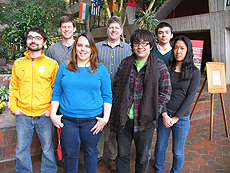Fermilab Theory Fellowship Program now in its third year and going strong
 |
Fermilab Theory Group Fellows. Top row, from left: Max Hansen, Andreas Kronfeld (program organizer), Alexander Kaurov. Bottom row, from left: Roberto Vega-Morales, Andrea Peterson, Chia Chang Chang, Chiu-Tien Yu |
When Roberto Vega-Morales arrived at Fermilab last fall as one of five 2012 Fermilab Theory Fellows, he said his expectations were high. Now in his fifth month of the fellowship program, Vega-Morales is surprised and happy to report that the experience has far exceeded his expectations and also helped him procure a postdoctoral position at the Laboratoire de Physique Théorique d'Orsay in Paris, France.
"I know for a fact that this fellowship went a long way toward helping me get that position," he said.
In 2010, Fermilab began offering fellowships to graduate students throughout the country studying theoretical particle physics or astrophysics. The motivation behind the program was to connect aspiring future theorists with some of today's leading experts to put the students on the path to success, said Andreas Kronfeld, who organizes the program. At the laboratory, the fellows conduct original research under the guidance of a Fermilab scientist, leading to papers that are published in refereed journals and that form part of their doctoral dissertations.
Vega-Morales currently works with Fermilab theorist Joe Lykken and will graduate with a Ph.D. in physics from Northwestern University this year. His work, which he will continue in Paris, involves the study of how the Higgs boson interacts with gauge bosons and determining how scientists might identify this interaction in a slew of Large Hadron Collider data.
"We want students to get the most out of their experience here," Kronfeld said. "Therefore, we select students whose research interests align best with the scientists they'll be working with at Fermilab."
Like Vega-Morales, 2011 Fermilab fellow Chiu-Tien Yu also found the experience helpful in preparing her for the postdoc position she will be taking at Stony Brook University in New York later this year.
"As part of this program you're treated more like a postdoc than a graduate student," she said. "You're given more independence and have the opportunity to come up with and pursue research ideas on your own."
Yu, who worked under the guidance of Fermilab theorist Roni Harnik, will graduate this year with her Ph.D. in physics from University of Wisconsin. She enjoys Fermilab so much, she said, that she decided to stay here another year on another stipend before continuing her research on LHC collider physics at Stony Brook.
One of Fermilab's first theory fellows, 2010 fellow Tim Linden, will start as a postdoc this year at the University of Chicago after graduating from the University of California, Santa Cruz, with a Ph.D. in physics. In fact, every Fermilab fellow who has graduated and those graduating this year have successfully secured a postdoc position. Vega-Morales, Yu and Linden all agree their experience at Fermilab helped.
Looking back, Linden suggested how current and future fellows can make the most of their time at the lab.
"Some of the top theorists and experimentalists in their fields are at Fermilab," Linden said. "I would recommend that all fellows talk to as many people doing research in the fields they find interesting and learn as much as they can from those valuable conversations."
—Jessica Orwig
|